Search the Special Collections and Archives Portal
Search Results

The Las Vegas skyline as seen from a lot on Soaring Rock Court, looking west and northwest, Henderson, Nevada
Date
2017-11-11
Archival Collection
Description
The Las Vegas Valley sits below the Ascaya luxury home development site as seen from a lot at the end of Soaring Rock Court.
Image
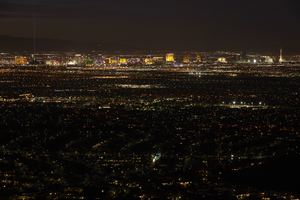
The Las Vegas skyline as seen from a lot on Soaring Rock Court, looking west and northwest, Henderson, Nevada: digital photograph
Date
2017-11-11
Archival Collection
Description
The Las Vegas Valley sits below the Ascaya luxury home development site as seen from a lot at the end of Soaring Rock Court.
Image
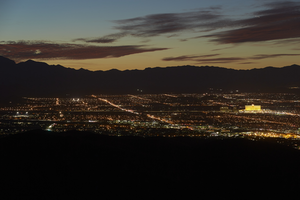
The southwestern edge of the Las Vegas valley as seen from a lot on Soaring Rock Court, looking west, Henderson, Nevada: digital photograph
Date
2017-11-11
Archival Collection
Description
The Las Vegas Valley sits below the Ascaya luxury home development site as seen from a lot at the end of Soaring Rock Court.
Image
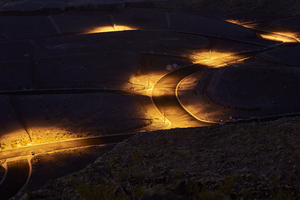
Streetlights in the Ascaya luxury home development as seen from Soaring Rock Court, looking north, Henderson, Nevada: digital photograph
Date
2017-11-11
Archival Collection
Description
Street lights illuminate roads in the Ascaya luxury home development site as seen from a lot at the end of Soaring Rock Court.
Image
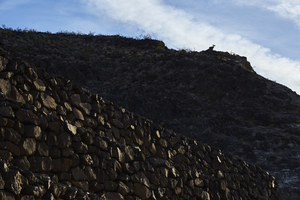
Desert bighorn ram at Ascaya development without homes, Henderson, Nevada: digital photograph
Date
2017-11-25
Archival Collection
Description
A desert bighorn ram sits perched on a mountainside above Cloudrock Court in the Ascaya luxury home lot development. Infrastructure for Ascaya, carved into the McCullough Mountain range in Henderson, Nevada, was completed with materials mined from the site.
Image
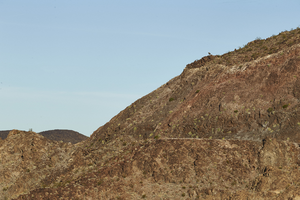
Desert bighorn ram at Ascaya development without homes, Henderson, Nevada: digital photograph
Date
2017-11-25
Archival Collection
Description
A desert bighorn ram sits perched on a mountainside above Cloudrock Court in the Ascaya luxury home lot development. Infrastructure for Ascaya, carved into the McCullough Mountain range in Henderson, Nevada, was completed with materials mined from the site.
Image
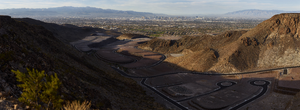
the Ascaya luxury home development with views of the Las Vegas Valley as seen from Cloudrock Court, Henderson, Nevada
Date
2017-11-25
Archival Collection
Description
The Ascaya luxury home development is carved out of the McCullough Mountain range in Henderson, affording unobstructed views of the Las Vegas Valley as seen from Cloudrock Court in the development's upper section.
Image
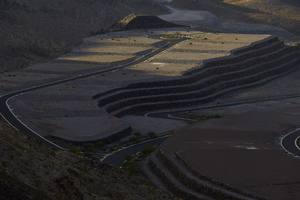
Highcrest Court in the Ascaya development without homes, Henderson, Nevada: digital photograph
Date
2017-11-25
Archival Collection
Description
Lots along Highcrest Court in the Ascaya luxury home lot development await further development. Infrastructure for Ascaya, carved into the McCullough Mountain range in Henderson, Nevada, was completed with materials mined from the site.
Image
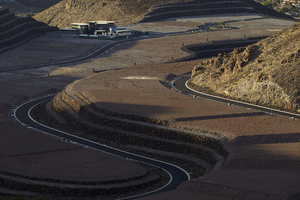
a home under construction in the Ascaya development on Sanctuary Peak Court, Henderson, Nevada: digital photograph
Date
2017-11-25
Archival Collection
Description
A single home under construction on Sanctuary Peak Court in the Ascaya luxury home lot development. Infrastructure for Ascaya, carved into the McCullough Mountain range in Henderson, Nevada, was completed with materials mined from the site. Ascaya Boulevard can be seen winding its way through the scene.
Image
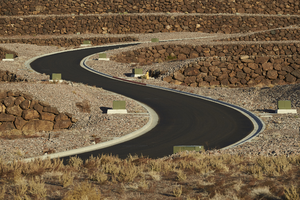
Cloudrock Court and home lots in the Ascaya development looking east, Henderson, Nevada: digital photograph
Date
2017-11-25
Archival Collection
Description
Cloudrock Court winds its way through the upper section of the Ascaya luxury home lot development. Infrastructure for Ascaya, carved into the McCullough Mountain range in Henderson, Nevada, was completed with materials mined from the site.
Image
Pagination
Refine my results
Content Type
Creator or Contributor
Subject
Archival Collection
Digital Project
Resource Type
Year
Material Type
Place
Language
Records Classification
